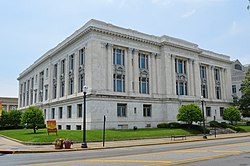2020 census
Madison County, Illinois – Racial and ethnic composition
Note: the US Census treats Hispanic/Latino as an ethnic category. This table excludes Latinos from the racial categories and assigns them to a separate category. Hispanics/Latinos may be of any race.| Race / Ethnicity (NH = Non-Hispanic) | Pop 1980 [13] | Pop 1990 [14] | Pop 2000 [15] | Pop 2010 [16] | Pop 2020 [17] | % 1980 | % 1990 | % 2000 | % 2010 | % 2020 |
|---|
| White alone (NH) | 229,372 | 228,315 | 231,313 | 233,515 | 213,793 | 92.60% | 91.61% | 89.33% | 86.72% | 80.42% |
| Black or African American alone (NH) | 14,162 | 16,074 | 18,825 | 21,066 | 24,671 | 5.72% | 6.45% | 7.27% | 7.82% | 9.28% |
| Native American or Alaska Native alone (NH) | 425 | 656 | 626 | 556 | 559 | 0.17% | 0.26% | 0.24% | 0.21% | 0.21% |
| Asian alone (NH) | 740 | 1,364 | 1,515 | 2,211 | 2,718 | 0.30% | 0.55% | 0.59% | 0.82% | 1.02% |
| Native Hawaiian or Pacific Islander alone (NH) | x [18] | x [19] | 50 | 92 | 92 | x | x | 0.02% | 0.03% | 0.03% |
| Other race alone (NH) | 497 | 116 | 237 | 206 | 825 | 0.20% | 0.05% | 0.09% | 0.08% | 0.31% |
| Mixed race or Multiracial (NH) | x [20] | x [21] | 2,450 | 4,323 | 12,404 | x | x | 0.95% | 1.61% | 4.67% |
| Hispanic or Latino (any race) | 2,495 | 2,713 | 3,925 | 7,313 | 10,797 | 1.01% | 1.09% | 1.52% | 2.72% | 4.06% |
| Total | 247,691 | 249,238 | 258,941 | 269,282 | 265,859 | 100.00% | 100.00% | 100.00% | 100.00% | 100.00% |
As of the 2020 census, the county had a population of 265,859. The median age was 40.3 years. 21.3% of residents were under the age of 18 and 18.1% of residents were 65 years of age or older. For every 100 females there were 95.2 males, and for every 100 females age 18 and over there were 92.7 males age 18 and over. [22] [23]
The racial makeup of the county was 81.4% White, 9.4% Black or African American, 0.3% American Indian and Alaska Native, 1.0% Asian, <0.1% Native Hawaiian and Pacific Islander, 1.5% from some other race, and 6.3% from two or more races. Hispanic or Latino residents of any race comprised 4.1% of the population, while non-Hispanic White residents comprised 80.4% of the population. [23]
83.6% of residents lived in urban areas, while 16.4% lived in rural areas. [24]
There were 108,607 households in the county, of which 28.4% had children under the age of 18 living in them. Of all households, 46.1% were married-couple households, 18.6% were households with a male householder and no spouse or partner present, and 27.9% were households with a female householder and no spouse or partner present. About 29.5% of all households were made up of individuals and 12.8% had someone living alone who was 65 years of age or older. [22]
There were 118,579 housing units, of which 8.4% were vacant. Among occupied housing units, 71.3% were owner-occupied and 28.7% were renter-occupied. The homeowner vacancy rate was 2.1% and the rental vacancy rate was 9.2%. [22]
2010 census
As of the 2010 census, there were 269,282 people, 108,094 households, and 71,756 families residing in the county. [25] The population density was 376.3 inhabitants per square mile (145.3/km2). There were 117,106 housing units at an average density of 163.7 per square mile (63.2/km2). [5] The racial makeup of the county was 88.2% white, 7.9% black or African American, 0.8% Asian, 0.2% American Indian, 0.9% from other races, and 1.8% from two or more races. Those of Hispanic or Latino origin made up 2.7% of the population. [25] In terms of ancestry, 32.7% were German, 14.9% were Irish, 10.5% were English, 7.5% were American, and 5.7% were Italian. [26]
Of the 108,094 households, 31.4% had children under the age of 18 living with them, 49.3% were married couples living together, 12.2% had a female householder with no husband present, 33.6% were non-families, and 26.8% of all households were made up of individuals. The average household size was 2.46 and the average family size was 2.98. The median age was 38.6 years. [25]
The median income for a household in the county was $51,941 and the median income for a family was $64,630. Males had a median income of $50,355 versus $35,543 for females. The per capita income for the county was $26,127. About 9.1% of families and 12.9% of the population were below the poverty line, including 19.3% of those under age 18 and 6.6% of those age 65 or over. [27]













